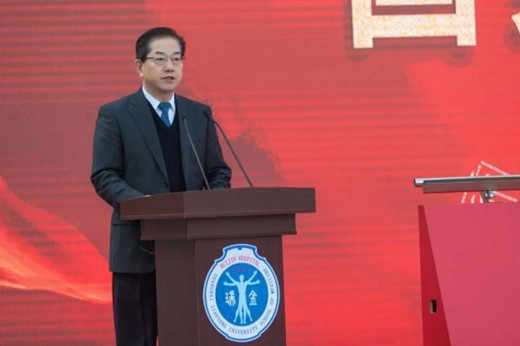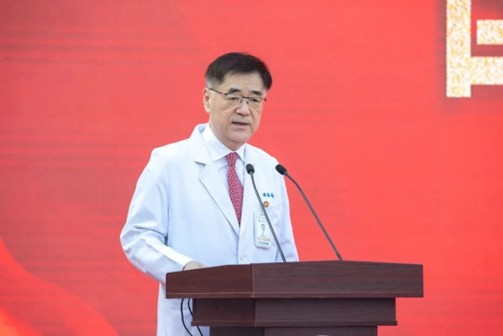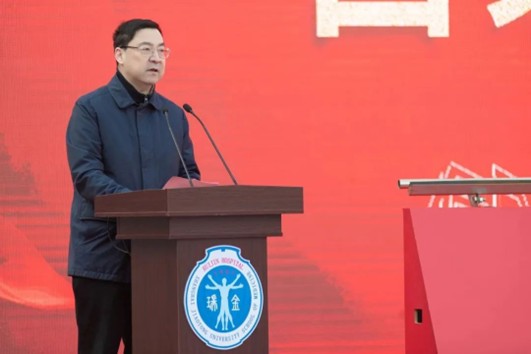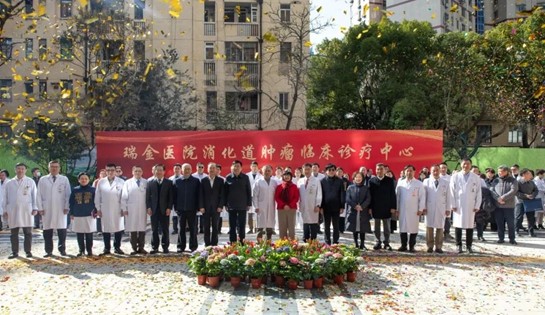On March 17, the National Emergency Medical Center of Ruijin Hospital, affiliated with Shanghai Jiao Tong University School of Medicine, officially broke ground. As a supporting project for the national emergency medical rescue base, the launch of this center marks a significant step forward for Ruijin Hospital in the field of emergency rescue.
In June 2023, Ruijin Hospital was selected as the only institution from Shanghai to be incorporated into the National Emergency Medical Rescue Base. As such, Ruijin Hospital will be responsible for the construction of the National Emergency Medical Rescue Base (Shanghai). The center will be located at the former site of Ruijin Hospital’s old outpatient building, which was once the largest outpatient facility in Shanghai. After fulfilling its historical mission, this site will be transformed into a modern medical rescue complex with a total floor area of 73,500 square meters. The center is designed to house 600 medical beds and will feature an emergency complex building, a multi-modal medical technology platform, and an intelligent transportation and aerial corridor system. The project is expected to be completed in June 2028, enabling seamless integration of all functional units and providing robust infrastructure for comprehensive rescue operations.
Since the project’s approval, Ruijin Hospital has been actively building an integrated "sea-land-air" emergency rescue system to ensure full preparedness for sudden emergency responses. The National Emergency Medical Center of Ruijin Hospital will integrate multidisciplinary resources, including emergency medicine, intensive care, burns, and infectious diseases, to establish a comprehensive, full-chain, and all-encompassing emergency medical rescue system. Seven key centers will be developed, covering talent training, patient transfer, warehousing, and distribution. The Huangpu Campus, located in the city center, will serve as the core rescue base for downtown Shanghai. The Jiading Campus, situated in northern Shanghai, will specialize in emergency medical rescue for infectious diseases and traffic injuries. The Jinshan Campus, located in southern Shanghai, will focus on rescue and treatment for nuclear and chemical injuries.
Through coordinated collaboration among these campuses, the center will establish a tiered and structured emergency medical rescue network that covers Shanghai, extends to the Yangtze River Delta region, and serves the entire country.

SJTUSM Chancellor Fan Xianqun stated that the establishment of the National Emergency Medical Center is a major strategic decision made by the central government of China from the strategic perspective of safeguarding national security and social stability. It is a key measure to comprehensively enhance China’s emergency medical rescue capabilities for unexpected incidents.
In recent years, with the support of authorities at all levels, Ruijin Hospital has achieved several important milestones: it became one of the first comprehensive national medical centers; Ruijin Hainan Hospital was designated a national regional medical center; and it was selected among the first batch of national pilot hospitals for high-quality public hospital development and modern hospital management systems. The hospital has consistently played a pivotal role in major public health emergencies, innovatively establishing an integrated "sea-land-air" emergency rescue system. It has achieved outstanding results in discipline development, talent cultivation, scientific and technological innovation, and medical services, making significant contributions to the construction of a world-class medical school.
Fan Xianqun emphasized that Shanghai Jiao Tong University School of Medicine will fully support the high-quality development of Ruijin Hospital, leveraging its advantages and resources to provide strong backing for the construction of the National Emergency Medical Center. He expressed his hope that Ruijin Hospital will take the establishment of the center as a new starting point, striving to enhance emergency medical treatment capabilities and lead Shanghai and the nation in emergency medical rescue efforts. He encouraged the hospital to set an example, take the lead, and pursue excellence in its development, contributing further to the realization of a "Healthy China" and a "Healthy Shanghai."

President of Ruijin Hospital Ning Guang emphasized that Ruijin Hospital has always adhered to its core mission of public welfare. As the only comprehensive national medical center in China that is not directly affiliated with the government, Ruijin Hospital has deepened its commitment to this mission by designating this year as the "Year of Public Welfare."
The newly launched Emergency Medical Rescue Center is a core project of the National Emergency Medical Rescue Base. This project will integrate resources from emergency and critical care disciplines, with a focus on enhancing emergency medical and trauma treatment capabilities. It aims to establish a highly responsive, 24/7 rescue network covering Shanghai and the Yangtze River Delta region.
The center will explore a full-chain emergency response system that includes disaster warning, pre-hospital emergency care, in-hospital treatment, and referral and triage. It will integrate functions such as emergency command, air rescue, research platforms, and material reserves to build a comprehensive rescue center at an international standard. This initiative will serve as the "Ruijin Solution" for safeguarding regional public health security.

Shen Jun delivered a speech at the groundbreaking ceremony.

The inauguration ceremony for the Gastrointestinal Tumor Clinical Diagnosis and Treatment Center
In addition to the National Emergency Medical Rescue Base (Shanghai), SJTUSM has also been approved to undertake the Shanghai Emergency Medical Rescue System Project for handling unexpected incidents. Several of its affiliated hospitals have been approved for various emergency medical rescue projects at the municipal level: Renji Hospital, Xinhua Hospital, and Shanghai Sixth People's Hospital have been approved as developing projects of Shanghai Emergency Medical Rescue Base. Renji Hospital, Xinhua Hospital, Shanghai Ninth People's Hospital, Shanghai General Hospital, and Shanghai Sixth People's Hospital have been approved as Shanghai Emergency Medical Rescue team developing projects.
Looking ahead, Shanghai Jiao Tong University School of Medicine and its affiliated hospitals will actively implement the development tasks for the national emergency medical rescue base, aligning with the requirements outlined in the Shanghai Action Plan for Strengthening Emergency Medical Rescue Systems for Unexpected Incidents (2024–2027). They will diligently advance key projects to effectively address the demands arising from natural disasters, industrial accidents, public health emergencies, and social security incidents. The school and its hospitals will work to enhance Shanghai's emergency medical rescue capabilities, establish a network that covers Shanghai, extends to the Yangtze River Delta, and serves the whole country, while also playing an active role in international emergency medical rescue efforts.

